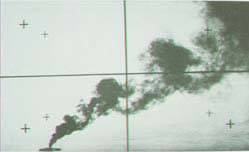Dilution in turbulent buoyant jets is caused by entrainment of surrounding ambient material into the discharge plume.
In this region, the initial jet characteristics of momentum flux,
buoyancy flux, and outfall geometry influence jet
trajectory and mixing.
Entrainment is a turbulent process caused by shear stress between the discharge flow and surrounding ambient fluid.
The effluent discharge plume is referred to simply referred to as the "flow".
A discharge with no buoyancy is referred to as a "nonbuoyant jet" or "pure jet".
A release of buoyancy only (no initial momentum) is called a "pure plume".
A discharge with both momentum and buoyancy is call a "buoyant jet" or "forced plume".
Positively buoyant flows are defined where the buoyancy force acts vertically upwards against the gravity force; negative
buoyancy is defined as acting downwards in the direction of the gravity force.


